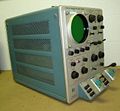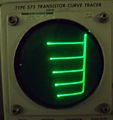575: Difference between revisions
Jump to navigation
Jump to search
No edit summary |
No edit summary |
||
| Line 1: | Line 1: | ||
The Tektronix 575 is a curve tracer for transistors. It can be thought of as being composed of three modules: | The Tektronix 575 is a curve tracer for transistors. It can be thought of as being composed of three modules: | ||
# An X-Y display. The vertical and horizontal amplifiers are very similar. | # An X-Y display. The vertical and horizontal amplifiers are very similar, using the two halves of a [[6CG7]] dual-triode tube as the output amplifier. The CRT has -1700V on the cathode and +2500V on the anode. The HV power supply uses two [[5642]] rectifier tubes. | ||
# A step source. This uses a gated miller integrator to generate controlled steps. The result is a staircase waveform, which generates different traces in the the family of I-V curves of the transistor. | # A step source. This uses a gated miller integrator to generate controlled steps. The result is a staircase waveform, which generates different traces in the the family of I-V curves of the transistor. | ||
# The collector sweep. Power from the mains goes through an isolation transformer and a variac and is rectified to produce the collector sweep voltage. The isolation transformer has two pairs of secondary taps, one for high voltage and low current, the other for low voltage and high current. The maximum power that can be delivered to the transistor in either mode is approximately 200 watts. | # The collector sweep. Power from the mains goes through an isolation transformer and a variac and is rectified by germanium diodes to produce the collector sweep voltage. The isolation transformer has two pairs of secondary taps, one for high voltage (0 to 200V) and low current, the other for low voltage (0 to 20V) and high current. The maximum power that can be delivered to the transistor in either mode is approximately 200 watts. | ||
Early versions used | It is possible to use the 575 as an X-Y monitor. The vertical and horizontal | ||
selenium rectifiers. | range switches have settings for external input, at 0.1 V/div sensitivity. | ||
Early 575 versions used [[selenium rectifiers]]. A kit for conversion to | |||
silicon diodes was available and is documented in the back of the manual. | |||
The 575 has a [[thermal cutoff]]. | |||
* [http://bama.edebris.com/download/tek/575-175/tek%20575%20&%20175.v6.pdf Tektronix 575 and 175 Manual (PDF)] | * [http://bama.edebris.com/download/tek/575-175/tek%20575%20&%20175.v6.pdf Tektronix 575 and 175 Manual (PDF)] | ||
Revision as of 21:18, 14 August 2011
The Tektronix 575 is a curve tracer for transistors. It can be thought of as being composed of three modules:
- An X-Y display. The vertical and horizontal amplifiers are very similar, using the two halves of a 6CG7 dual-triode tube as the output amplifier. The CRT has -1700V on the cathode and +2500V on the anode. The HV power supply uses two 5642 rectifier tubes.
- A step source. This uses a gated miller integrator to generate controlled steps. The result is a staircase waveform, which generates different traces in the the family of I-V curves of the transistor.
- The collector sweep. Power from the mains goes through an isolation transformer and a variac and is rectified by germanium diodes to produce the collector sweep voltage. The isolation transformer has two pairs of secondary taps, one for high voltage (0 to 200V) and low current, the other for low voltage (0 to 20V) and high current. The maximum power that can be delivered to the transistor in either mode is approximately 200 watts.
It is possible to use the 575 as an X-Y monitor. The vertical and horizontal range switches have settings for external input, at 0.1 V/div sensitivity.
Early 575 versions used selenium rectifiers. A kit for conversion to silicon diodes was available and is documented in the back of the manual. The 575 has a thermal cutoff.




